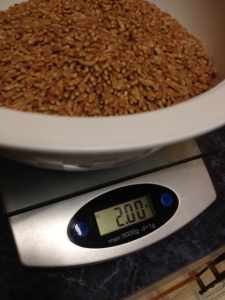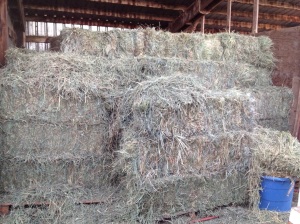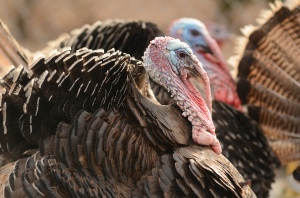I’ve been reading a lot lately about fodder. The fodder I’m speaking about is sprouted grains that you can feed to your livestock and replace almost all grains that are fed to them. There are systems that you can purchase that will grow the fodder for you. One of the companies that builds them is located about 3 hours away from me. They are called FodderFeeds out of Bend, Oregon. I am more than certain their equipment is wonderful, and some day I would like to get one, but I’m just not sure if my animals will like it nor do I have the extra money right now to purchase even one of the small systems. So, I thought I would start a small trial here at home and see if the chickens, alpacas, turkeys and cows will like it. Then I’ll start thinking about it. 🙂
So what you do is take whole grain, soak it and then spread it in trays and 7-9 days later you have sprouted grain that looks like grass. Why is this important. Well, take dry barley for instance. Only about 30% is digestible. You sprout it, and 7 days later it is 82% digestible and the protein had increased as well as many other nutrients for the animals. For ruminants like alpacas and cows, this will still only be a supplement. Pigs and chickens it could be their only feed beyond on what they get by grazing. Here is a picture of what fodder looks like once it has been growing about 7 days. The white layer is the roots that are 100% edible. The brown is the sprouted grains and the green is the growth. All, 100% edible. This stuff is amazing. Many people’s blogs I have read like to snack on it while it is growing and they say that it is really sweet.
So why am I doing this? Well, to be honest, first and foremost, to save money. If I can take about 2 pounds of dry grain and get about 15 pounds of fodder to feed to the animals, everyday, this will save me not only on grain (I won’t buy any but to sprout) and I will be able to cut down on my hay purchase every year. This year we spent over $1300 on hay just for the alpacas alone. The second reason, and one of the main reasons I am moving on is the health of the animals. This will give them a better feed throughout the year, even when we don’t have green pastures. It will help our cow to give better milk, our alpacas to have better fleece, and our chickens to be healthier even longer.
So today I started our fodder experience. I am going to try and sprout out 2 pounds of some wheat I had in the garage. Here are some pictures from these first steps.

Here is the wheat we had. As you can see, it is old, from 2004. It has been sealed tight until I opened it today.

I weighed out 2 pounds of dry grain.

I rinsed it very well, I wanted to get the chaff out and to make sure it was clean.

I was surprised how clean it was. Not a speck of chaff. I rinsed it 3-4 times and then filled it back up with water to about this height with water.

I then placed it in our pantry where it will keep a constant temperature and stay dark. I’ll let it sit for 12 hours and then I’ll drain it and go on to step 2 of the process.
If you would like to continue to follow this project, follow along on my farm web page, Silk Creek Farm.
My wish is that I’ll be able to get a good system up an going here at home to get me started, and then I’ll start putting money in my savings account and start saving for a professional larger system that will grow with no problems because of outside temperature or any other issues.








